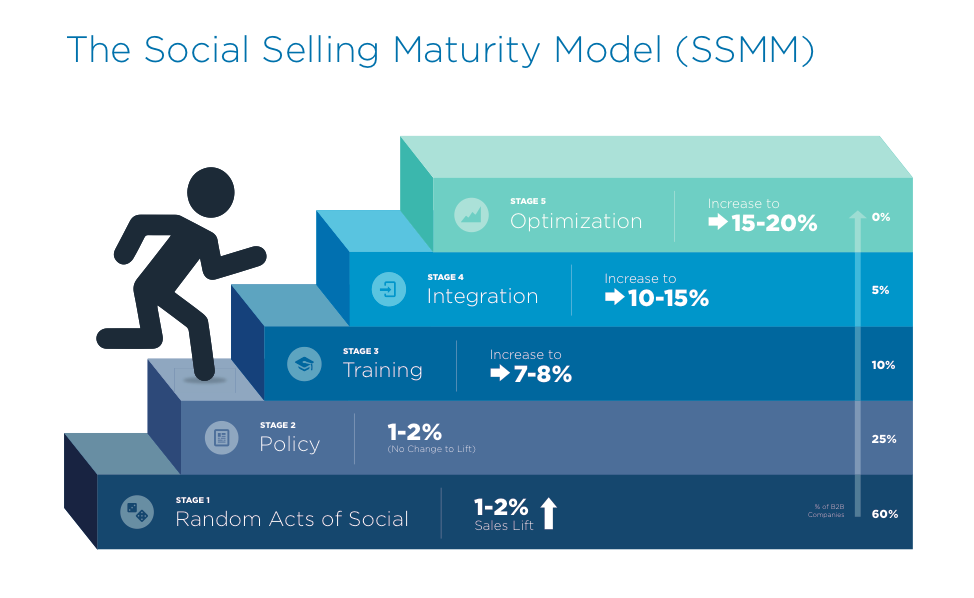Where Does Your Company Fall On The Social Selling Maturity Model?
- Published in Demanding Views
 By Michael Idinopulos, CMO, PeopleLinx
By Michael Idinopulos, CMO, PeopleLinx
Social selling is a journey, and most enterprises are just getting started.
Multiple studies have found that sales professionals who use LinkedIn, Twitter and other social networks to sell consistently outperform their peers who don’t. For example, Aberdeen Group has found that 46% of social sellers make quota, compared to only 38% for reps who don’t practice social selling.
Yet relatively few sales teams are taking advantage of the social selling opportunity.
In PeopleLinx’s 2014 survey of B2B sales professionals, only 31% of respondents reported using social as part of their selling process. With just 26% of respondents feel they know how to use social media effectively for selling, it’s no wonder organizations struggle to unlock the social selling opportunity.
Fixing this problem isn’t easy for sales leaders. Social selling can’t be “turned on” simply by throwing a switch or even hiring a trainer.
Implementing social selling requires sales professionals to change the way they do business every day. Changing the team’s selling behavior is one of the most difficult challenges a sales manager can tackle.
Backed by extensive survey data and hands-on experience working with hundreds of sales organizations, PeopleLinx has developed an Enterprise Social Selling Maturity Model (SSMM).
PeopleLinx research found that sales teams progress through five distinct stages on their way to social selling excellence: Random Acts of Social, Policy, Training, Integration, and Optimization.

Stage 1: (Random Acts of Social) — This is where all organizations start. Reps are on their own when it comes to social selling. Activity is driven by the innovation and resourcefulness of early adopters who see the potential of social selling and seize the initiative without asking for help or permission. There is no organizational governance, coordination, or risk management.
Stage 2: (Policy) — Management becomes concerned about potential risks associated with salespeople publishing content directly to the market. Marketing, PR, Legal, and/or Compliance step in to write a social media policy. In regulated industries, a compliance solution is launched.
Stage 3: (Training) — Sales organizations offer basic training on how to use LinkedIn, Twitter, and other social networks. Curriculum covers selling techniques like personal branding, etiquette for making new contacts, social prospecting, and content sharing, as well as compliance policy around topics like endorsements, client confidentiality, and intellectual property.
Stage 4: (Integration) — Companies advance beyond training as a one-off initiative and weave social into every aspect of their selling playbook. Individual reps are given social tasks or “to-dos” based on their leads, pipeline, and account assignments in CRM. Tracking and reporting on social activity becomes a core activity for Sales Ops.
Stage 5: (Optimization) — In this highest stage of social selling maturity, sales organizations analyze empirical data on past success to guide future actions on social.
Sales leaders should approach social selling as an organizational journey. In the early stages, the top-line benefits of social selling can be modest. Random Acts of Social, for instance, only generate a 1% to 3% sales lift. As the journey continues, the benefits increase dramatically. Our analysis found that when sales teams reach the Integration and Optimization stages, sales productivity can improve by more than 15%.
The question for sales leaders is not whether to adopt social selling, but how — and how quickly — to integrate it into sales process.
Click here to download the full Social Selling Maturity Model.
Michael Idinopulos is CMO of PeopleLinx, a vendor of products and services to enhance branding, distribute content, and build relationships through social networks.

